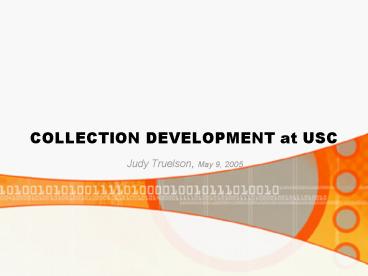COLLECTION DEVELOPMENT at USC - PowerPoint PPT Presentation
1 / 15
Title:
COLLECTION DEVELOPMENT at USC
Description:
USC Information Services Division's Six Information Pathways to. Excellence ... Conspectus: Guidelines for Collection Development Policy Using the Conspectus Method ... – PowerPoint PPT presentation
Number of Views:27
Avg rating:3.0/5.0
Title: COLLECTION DEVELOPMENT at USC
1
COLLECTION DEVELOPMENT at USC
- Judy Truelson, May 9, 2005
2
- Collection Development Organization at USC,
2005, as framed by - USC Information Services Divisions Six
Information Pathways to - Excellence
- User-driven seamless collections access
- Interdisciplinary centers
- Virtual Campus Infrastructure
- Federal Support System
- Web-based Service Environment
- Strategic Facilities
- 2) Resources Services Re-Alignment
- Art Humanities Team
- Science Team
- Social Sciences Team
- Undergraduate Team
- Special Materials Team
3
- SMART Goals S specific M measurable
- A attainable R realistic T tangible
- Collection Development SMART Goals
- Enhance and Update Serials Management Database
- Coordinate and Facilitate Interdisciplinary Teams
review and possible reallocation of their
materials budget allocations. - Complete selector workflow process mapping
4
Selector Mapping
5
- Emphasis on Establishing Selector Competencies
through - Mapping CD Functions for systems Analysis
- Training
- Over Arching CD principles
- Monographic selection
- Approval Plans
- Firm Orders
- Subject Profiling
6
- Questions? Discussion.
- ?Issues?, i.e.,
- How does professional autonomy stack up against
efficiency and effectiveness? - What are the core functions of Librarianship (?)
- What is the best way to bring about change?
7
- Origins of the Statewide California Electronic
Library Consortium (SCELC) - Originally hosted by USC from 1986 through the
late 1990s as the Southern California Electronic
Library Consortium - Administration gradually migrated to the
University of Judaism Ostrow Library - SCELC, in the late 1990s, expanded its membership
from approximately 30 libraries to more than 75
libraries - SCELC covers nearly all the private academic
libraries in California (except for Stanford)
8
- Mission of SCELC
- The consortium seeks to explore issues related
to electronic and digital information for the
benefit of faculty and students in the member
institutions. It further seeks to improve related
library staff skills through development and
training activities. - Pricing Models
- FTE-based
- Size varies from lt100 FTE to gt30,000 FTE
- Tiered to number of sites
- Flat fee for all libraries regardless of size
- Carnegie classification of institution
- One lump sum price divided equally (rare)
- Minimum price per library with additional cost
based on FTE for each library - Materials budget-based (also rare)
9
- SCELC A Model for Collaborative Collection
Development - Best Practices in collaborative Collection
Development - Formation and Founding
- History and tradition of successful cooperation,
i.e., shared electronic licensing - Commitment to provide funding to the cooperative
project - Shared commitment to the cooperative mission
- Decision Making, Organization and Administration
- Communication/Education
- Incorporation, with bylaws, an executive
director and executive board - Funding and Infrastructure
- Visible collections through web (or union
catalog) SCELC - Reciprocal interlibrary loan agreements
- Shelton, Cynthia, The New Dynamic of Cooperative
Collection Development
10
- Questions? Discussion.
- ?Issues?, i.e.,
- Would the SCELC model fit Arkansas?
- How much difference is there in collaboration for
public vs. private institutions?
11
- Collection Assessment Now and in Future
- LibQUAL
- What is LibQUAL ?LibQUAL is a suite of
services designed to analyze users opinions of
service quality. The programs centerpiece is a
rigorously tested Web-based survey bundled with
local training that helps libraries assess and
improve library services.
12
- Radar Charts allow gap analysis to interpret
results
13
- If scores are within the zone of tolerance, The
service adequacy gap is positive because users
perceptions are higher than their minimum
expectations, although lower than their desired
expectation
14
- YBP Peer Reports GOBI2
- Peer Ranking
- Peer Comparison
- RLG Conspectus Guidelines for Collection
Development Policy Using the Conspectus Method - Overview of Approaches to Collection Assessment
15
- Questions? Discussion.
- ?Issues?
- Who are the primary stakeholders in collection
development? - How well do assessment strategies address their
issues? - _______________________________________________
- Thank you for this opportunity to share
information - about collection development!































